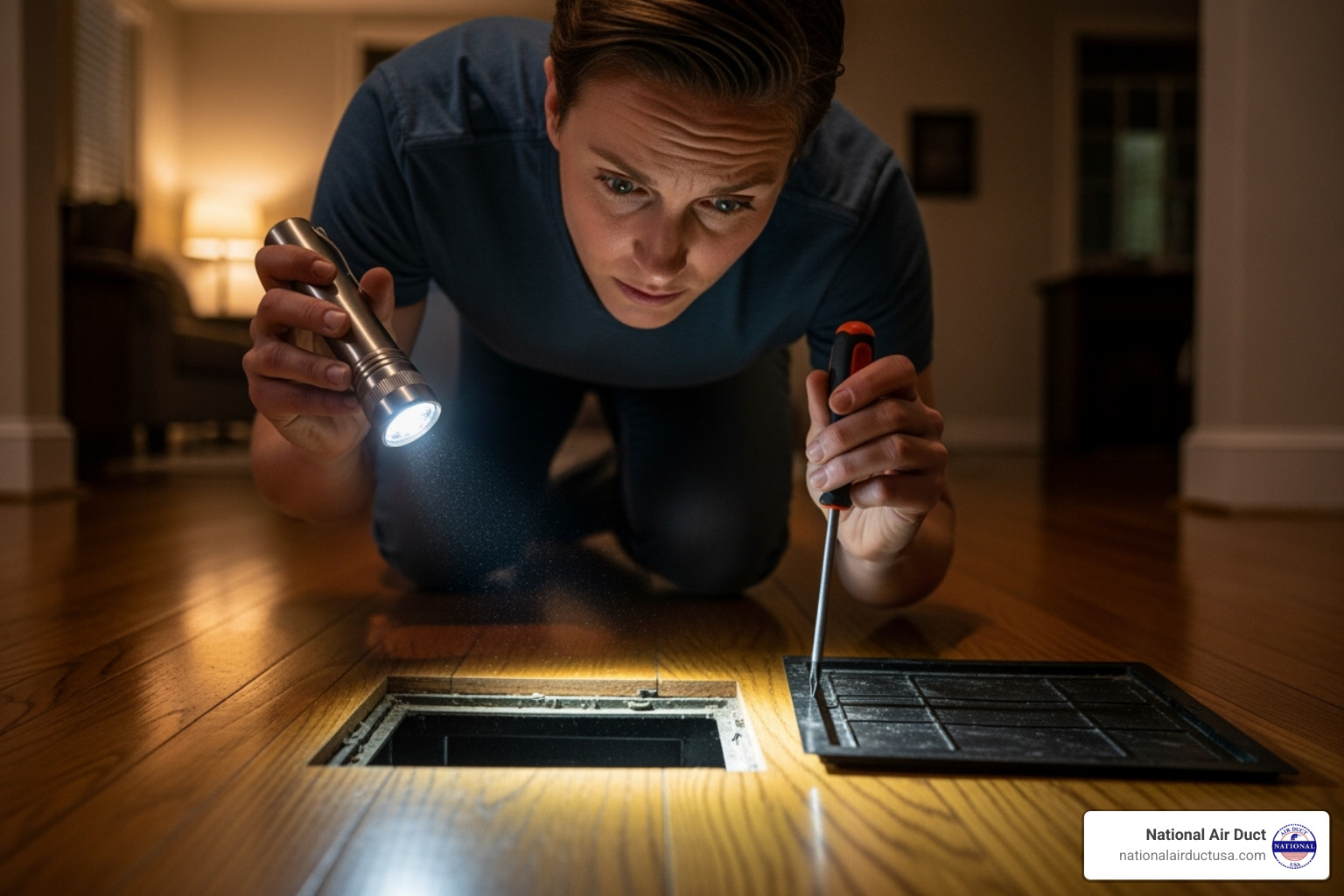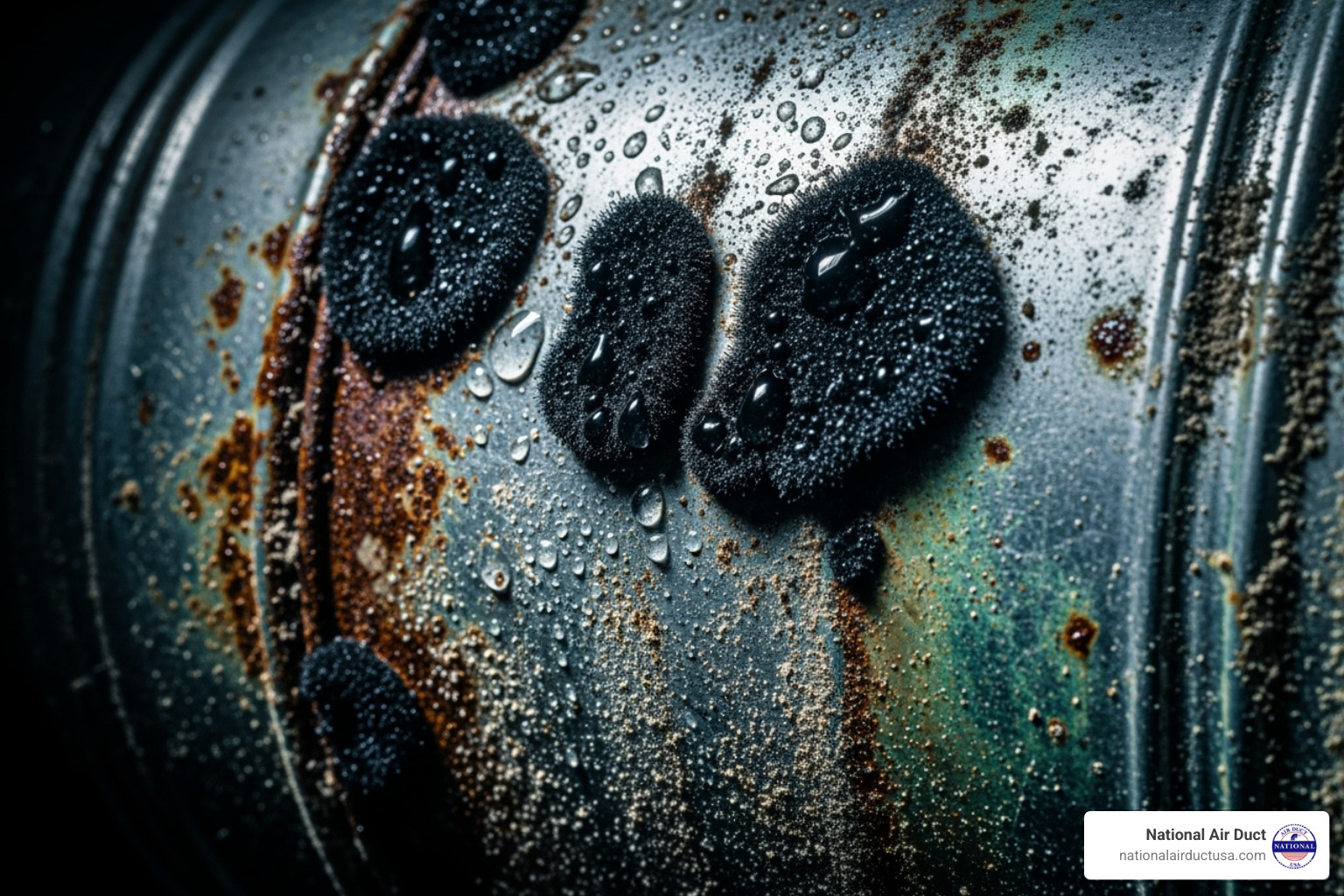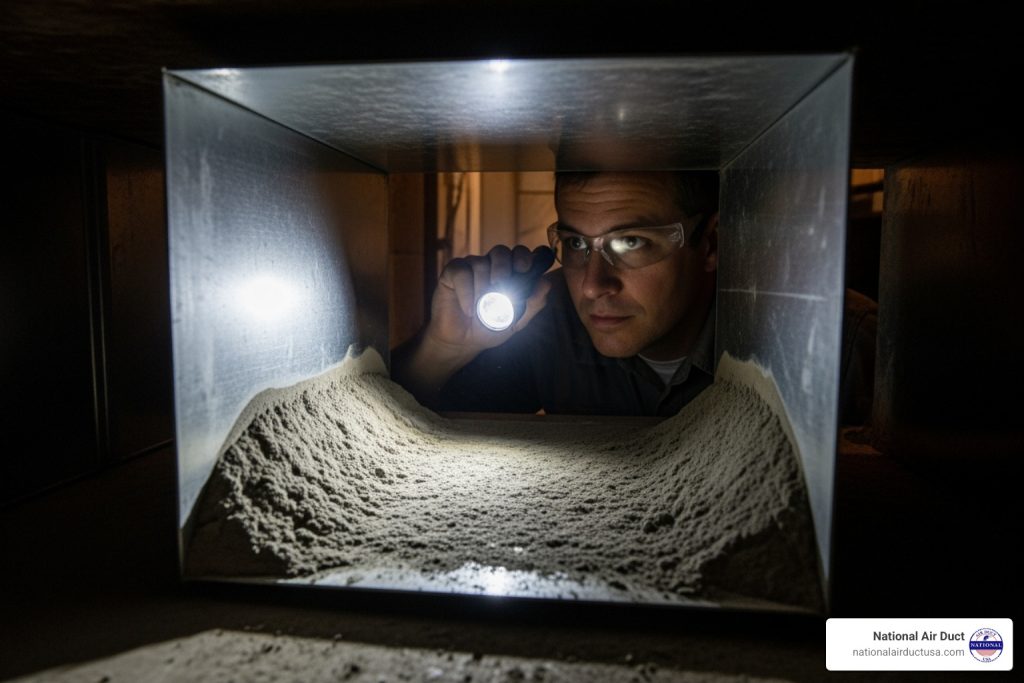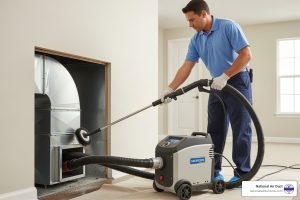Why Air Duct Inspection Matters for Your Home’s Health and Efficiency
Air duct inspection is the process of visually examining your home’s HVAC system ductwork to identify dust buildup, mold growth, pest infestations, air leaks, and structural damage that can impact indoor air quality and system efficiency.
Quick Answer for Air Duct Inspection:
- What it is: Visual examination of ductwork for contaminants and damage
- DIY tools needed: Screwdriver, flashlight, smartphone camera, small mirror
- Key signs to check: Dust buildup, mold, pest droppings, air leaks, damaged insulation
- When to call pros: Visible mold, excessive debris, pest infestations, structural damage
- Frequency: DIY checks annually, professional inspection every 3-5 years
Your home’s HVAC system works like the lungs of your house, recirculating air an average of 5-7 times per day. That means whatever is lurking in your ducts – dust, pet dander, mold spores, or even dead rodents – gets blown throughout your living space repeatedly.
The good news? You don’t need expensive equipment to spot many common duct problems. With basic tools like a screwdriver and flashlight, you can perform a preliminary inspection that reveals whether your ducts need professional attention.
This guide will show you exactly how to safely inspect your air ducts, what warning signs to watch for, and when it’s time to call in NADCA-certified professionals. You’ll learn to identify issues that could be costing you money on energy bills or potentially affecting your family’s health.

Quick Air duct inspection definitions:
Why Bother Inspecting? The Hidden Benefits for Your Home
Let’s be honest – crawling around looking at dusty air ducts isn’t exactly anyone’s idea of a fun weekend activity. But here’s the thing: air duct inspection offers some pretty amazing benefits that go way beyond just satisfying your curiosity about what’s lurking in those metal tunnels.
Think of your ductwork as your home’s respiratory system. Just like you wouldn’t ignore a persistent cough, you shouldn’t ignore what’s happening in the pathways that deliver air throughout your house.
Improved indoor air quality is probably the biggest win you’ll get from regular inspection. Over time, your ducts become a collection point for all sorts of unwelcome guests: dust, pet dander, pollen, and even mold spores. Every time your HVAC system kicks on, these contaminants get blown around your home like confetti at a party nobody wanted to attend.
If someone in your family suffers from allergies or asthma, dirty ducts can be a major trigger. We’re talking about increased sneezing, coughing, watery eyes, and difficulty breathing. It’s like having an invisible enemy that attacks every time you try to relax at home.
But the benefits don’t stop at health. Air duct inspection can also boost your HVAC efficiency dramatically. When your ducts are clogged with debris, your system has to work overtime to push air through – kind of like trying to breathe through a straw. This extra effort translates directly into higher utility bills and can seriously shorten your system’s lifespan.
Regular inspection helps you catch small problems before they become expensive nightmares. Trust me, replacing a $20 air filter is a lot easier on your wallet than replacing an entire HVAC system that died from overwork.

The Link Between Clean Ducts and Energy Savings
Here’s a number that might surprise you: clean ductwork can make your HVAC system up to 40% more efficient. That’s not just a small improvement – that’s a game-changer for your monthly energy bills.
When dust and debris build up in your ducts, it’s like putting a partially closed valve on your air flow. Your furnace or air conditioner has to strain harder to maintain your desired temperature, burning through energy like a gas-guzzling truck climbing a mountain.
But efficiency isn’t just about cleanliness – it’s also about keeping your conditioned air where it belongs. Get this: 20-30% of your heated or cooled air can escape through leaky ductwork. Imagine paying to condition air, only to have nearly a third of it disappear into your attic, crawl space, or wall cavities!
Those leaks don’t just waste energy – they can actually pull in dirty, unconditioned air from those not-so-clean spaces. Sealing these leaks is one of the most cost-effective improvements you can make to your home. Learn more about duct sealing from ENERGY STAR to see how much you could save.
Protecting Your Family’s Health
Your home should be your safe haven – a place where you can breathe easy, literally. Unfortunately, contaminated ducts can turn your sanctuary into a source of airborne contaminants that affect your family’s respiratory health.
Every day, your ducts collect microscopic hitchhikers: pet dander from Fluffy’s latest grooming session, bacteria that multiply in dark, moist conditions, and mold spores that love to set up camp in humid ductwork.
The EPA notes that while some household dust in ducts is normal, heavily contaminated systems with visible mold, pests, or excessive debris can pose real health risks. For family members with respiratory sensitivities, minimizing exposure to these contaminants isn’t just nice to have – it’s essential.
Regular air duct inspection gives you the peace of mind that comes from knowing exactly what’s circulating through your home’s air. It’s about taking proactive care of your family’s health, one breath at a time.
How to Perform a DIY Air Duct Inspection
Ready to become a detective in your own home? Performing a basic air duct inspection yourself is easier than you might think, and it can save you both money and worry. Think of it as giving your home’s respiratory system a quick health check-up.
Before we dive into the fun stuff, let’s talk safety first. Always turn off your HVAC system at the thermostat before you start poking around. The last thing you want is the system kicking on while you’re elbow-deep in a vent, blowing dust directly into your face (trust us, it’s not pleasant).
Grab a dust mask or N95 respirator to protect your lungs from any accumulated dust or spores you might disturb. Wearing gloves is also smart – ductwork can have sharp edges, and you never know what you might encounter in there.

Gearing Up: Tools for Your DIY Check
The beauty of a DIY air duct inspection is that you probably already have most of the tools you need lying around the house. Here’s what to gather before you start:
You’ll need a screwdriver to remove vent covers – nothing fancy, just whatever fits the screws on your vents. A high-powered flashlight is absolutely essential because ductwork is dark, and you want to see what’s really going on in there. Your smartphone camera might be your most valuable tool – the flash can illuminate areas your eyes can’t reach, and you can take photos or videos to document what you find.
A small mirror works wonders for peeking around corners or into tight spaces where your head won’t fit. Keep some damp rags handy for wiping down vents and cleaning up any dust you shake loose. Finally, having HVAC aluminum foil tape on standby is smart – if you spot any obvious air leaks during your inspection, you can make quick temporary repairs.
The Visual Check: What to Look for at Vents and Registers
Start your inspection journey at the most accessible spots – your home’s air vents and registers. These are like windows into your ductwork’s soul, often revealing the first clues about what’s happening deeper in the system.
Take a walk around your home and really look at each vent. Do you see dust buildup that looks more like a fuzzy sweater than a light coating? Are there tumbleweeds of pet hair dancing around the edges? These visible signs often hint at what’s lurking inside.
Now comes the slightly more involved part. Unscrew a few vent covers – pick one supply vent (where air comes out) and one return vent (where air gets sucked back in). Don’t worry, you’re not breaking anything! Once you remove the cover, grab your flashlight and peer inside.
Taking photos inside the ducts with your smartphone is incredibly helpful. The camera flash can reveal details your eyes might miss, and you’ll have documentation if you need to call in professionals later. Look for excessive dust that seems thick and cakey, any debris like toys or construction materials that shouldn’t be there, and check for obstructions that might be blocking airflow.
Pay attention to uneven airflow too. If some rooms feel stuffier than others, or if certain vents barely whisper while others roar, you might have blockages or leaks affecting your system’s balance.
Deeper Investigation: A Basic Air Duct Inspection
Once you’ve surveyed the vents, it’s time to visit the heart of your HVAC system. Head to your furnace area – usually in the basement, utility room, or garage.
Start by inspecting the blower compartment if you can access it safely. The blower is like your system’s lungs, and if it’s caked with dust, it can’t breathe properly. Shine your flashlight in there and see if the blower blades look clean or if they’re wearing a thick coat of grime.
Don’t forget to check your air filter condition – it might seem obvious, but a clogged filter is the most common cause of poor air quality and reduced efficiency. If it looks like it’s been through a dust storm, replace it immediately.
Now for the detective work. Look for visible ductwork in your basement or attic and examine it carefully. Damaged insulation around ducts is a red flag – if it’s torn, sagging, or wet, you’re losing energy and potentially creating moisture problems.
Damp spots or water stains are serious concerns that could indicate leaks or the perfect conditions for mold growth. If you find wet or moldy insulation around ducts, know that it can’t be effectively cleaned and will need professional replacement.
Detecting air leaks is easier than you might think. With your system running briefly, hold a damp hand or a thin piece of tissue near duct connections and seams. Feel a breeze where there shouldn’t be one? You’ve found a leak where your expensive conditioned air is escaping, and outside air is sneaking in.
This hands-on approach gives you a real picture of your ductwork’s health and helps you decide whether it’s time to call in the NADCA-certified professionals.
Red Flags: When to Stop and Call a Professional
Sometimes the best part of a DIY project is knowing when to put down your tools and call in the experts. While your air duct inspection can reveal a lot about your system’s health, certain findies should make you step back immediately. These aren’t just minor inconveniences – they’re serious issues that require professional equipment, training, and safety protocols.
Think of it this way: you might be comfortable changing a light bulb, but you’d call an electrician to rewire your house. The same logic applies to ductwork. Some problems are simply too complex, too dangerous, or too specialized for a weekend warrior approach.

Signs of Mold or Pest Infestation
If you encounter any signs of biological contamination during your air duct inspection, it’s time to stop immediately and call professionals. These situations can actually become worse if handled incorrectly, potentially spreading contamination throughout your entire home.
Musty odors are often your nose’s first warning that something isn’t right. That damp, earthy smell coming from your vents usually means mold or mildew has found a cozy home in your ductwork. Don’t ignore it – your nose is rarely wrong about these things.
Visible mold growth is an absolute stop sign. Whether it’s black, green, white, or any other color, fuzzy patches inside your ducts require immediate professional attention. Trying to clean mold yourself can actually make things worse by releasing spores into your home’s air. Professional mold remediation involves specialized equipment and containment procedures that protect your family’s health.
Water damage stains on duct materials tell a story of moisture problems, and where there’s been moisture, mold often follows. These discolored areas indicate that your ductwork has been compromised and needs expert evaluation.
Finding rodent droppings, nests, or dead insects means you’re dealing with more than just dirty ducts. Pests can chew through ductwork, leave hazardous waste behind, and create serious health risks. Professional cleaning services can safely remove contaminated materials and help identify how these unwelcome guests got in. Research shows that about 90% of mold tests in dirty ducts come back positive, which explains why professional assessment is so important. You can find more info about disinfecting air ducts.
Excessive Debris or Structural Damage
Physical damage to your ductwork is another clear signal to call in the professionals. These issues go beyond what basic cleaning can fix and often require specialized repair or replacement.
Post-renovation dust and excessive debris accumulation can be more serious than they appear. If you’ve recently had construction work done, the dust and debris can actually damage your HVAC equipment and continuously circulate unhealthy particles throughout your home. While a thin layer of household dust is normal, thick accumulations of construction debris, lint, or other materials need professional removal. Learn about post-renovation cleaning.
Clogged ducts that are severely blocked can put tremendous strain on your HVAC system. When airflow is dramatically restricted, your system works overtime, leading to higher energy bills and potential equipment failure.
Collapsed sections or major structural damage to your ductwork require immediate professional attention. Large tears, disconnected joints, or sections that have completely given way aren’t just efficiency problems – they’re pulling in contaminated air from crawl spaces, attics, or wall cavities. These major air leaks can account for 20-30% of your conditioned air disappearing before it reaches your living spaces.
When you find any of these red flags, calling a professional isn’t admitting defeat – it’s making a smart decision to protect your home and family. Our NADCA-certified experts at National Air Duct USA have the training, equipment, and experience to safely address these complex issues and get your system back to optimal health.
The Professional Approach: What to Expect from an Expert
When your DIY air duct inspection uncovers problems that need professional attention, choosing the right service makes all the difference. Think of it like finding a good doctor – you want someone with proper credentials, experience, and a track record you can trust.
We’re proud to be NADCA-certified at National Air Duct USA. NADCA (National Air Duct Cleaners Association) sets the gold standard for our industry, and their certification means we follow strict guidelines for quality and ethics. Our technicians hold specialized certifications like Air Systems Cleaning Specialist (ASCS) and Certified Ventilation Inspector (CVI) – fancy titles that basically mean we know what we’re doing and stay up-to-date on the latest techniques.
This certification matters because, unfortunately, the air duct industry has its share of bad actors. You’ve probably seen those “$99 whole house specials” that sound too good to be true – and they usually are. These services often provide superficial cleaning or hit you with hidden fees once they’re in your home.
A reputable service will always provide a written estimate that clearly outlines the total cost and scope of work before starting. We should also show you proof of insurance without you having to ask. Don’t be shy about asking questions – we love talking about our process, equipment, and certifications because we’re genuinely proud of our work. If you have fiberglass ducts, you can find NADCA standards for fiberglass ducts here to see exactly what standards we follow.
Advanced Tools and Techniques
The difference between a DIY air duct inspection and what professionals can accomplish is like comparing a magnifying glass to a high-powered microscope. We use specialized equipment that reveals problems invisible to the naked eye.
Our video inspection cameras are probably our coolest tool. These aren’t your average cameras – they’re designed specifically for HVAC work, with LED lights and flexible cables that can snake through your entire duct system. We can see every nook and cranny, even in spots that would be impossible to reach otherwise. The best part? We can record everything and show you exactly what we find, so there are no surprises or mysterious recommendations.
Beyond the cameras, we use airflow meters to measure how efficiently air moves through your system, particle counters to check air quality before and after our work, and moisture meters to detect hidden dampness that could lead to mold growth. It’s like having a complete health checkup for your HVAC system.
Here’s something many people don’t realize: truly comprehensive cleaning goes way beyond just the ducts themselves. We inspect and clean your coils, drain pans, humidifiers, and blower fans too. Why? Because if we leave even one component dirty, it can recontaminate your entire system. It’s like washing your car but leaving the tires muddy – pretty soon, everything’s dirty again.
Our goal is simple: give you the cleanest, most efficient HVAC system possible. When everything works together properly, you’ll notice better air quality, lower energy bills, and the peace of mind that comes from knowing your family is breathing cleaner air. You can explore our Residential Air Duct Cleaning services to see our complete approach in action.
Frequently Asked Questions about Air Duct Inspections
We get tons of questions about air duct inspection from homeowners just like you. Here are the answers to the most common ones that might be on your mind too.
How often should I perform an air duct inspection?
Here’s the simple truth: you should do a basic DIY visual check at least once a year. Think of it like checking your smoke detector batteries – it’s one of those small annual maintenance tasks that can save you big headaches later.
Your yearly air duct inspection doesn’t need to be complicated. Just pop off a few vent covers, shine a flashlight inside, and take a quick look around your furnace area. This simple check helps you catch problems while they’re still small and manageable.
For professional inspections, we recommend having a NADCA-certified expert like our team take a look every 3-5 years under normal circumstances. But life isn’t always normal, is it?
You might need more frequent professional attention if you have pets that shed like crazy (we’re looking at you, golden retriever owners!), family members with allergies or asthma, or you’ve recently had renovations that kicked up dust everywhere. If you’ve dealt with water damage or notice unexplained musty odors, don’t wait – get that inspection scheduled right away.
Is air duct cleaning really necessary?
This question sparks more debate than pineapple on pizza! The EPA takes a cautious stance, saying that routine cleaning isn’t always necessary since much of the dust in ducts stays put and doesn’t necessarily blow into your living space.
But here’s where it gets clearer: the EPA does recommend cleaning when you have visible mold growth inside your ducts, pest infestations (nobody wants mouse droppings in their air supply!), or excessive dust and debris that’s actually getting blown into your home.
The truth is, every home is different. While scientific studies on general health benefits are limited, we’ve seen countless families breathe easier after cleaning heavily contaminated ducts. If your air duct inspection reveals significant buildup, mold, or pests, cleaning becomes a no-brainer for your family’s comfort and health.
Can I just vacuum my ducts myself?
We love your DIY spirit, but this is one area where your trusty household vacuum just can’t compete with professional equipment. You can vacuum around the register openings and maybe reach a few inches into the ductwork, but that’s like trying to clean a swimming pool with a coffee cup.
Your home vacuum simply can’t reach the long runs of ductwork snaking through your walls, attic, and basement. Professional equipment uses high-CFM vacuums (often 5000 cubic feet per minute or more) with the power to pull debris from the entire system – that’s roughly 10 times stronger than your household vacuum.
Even more important, effective duct cleaning requires specialized brushes and agitation tools to dislodge stubborn contaminants from duct surfaces. Without these tools, you’re basically just moving dust around instead of removing it.
Here’s the kicker: improper DIY attempts can actually release more dust into your living space, making your indoor air quality temporarily worse. When you need real results, professional equipment and expertise make all the difference in getting your ducts truly clean.
Conclusion: Breathe Easier with a Clean Ventilation System
Think of your air duct inspection journey as learning to read your home’s vital signs. Just like checking your pulse or blood pressure gives you insights into your health, examining your ductwork reveals the hidden story of your indoor environment.
Throughout this guide, we’ve walked you through the simple steps of a DIY inspection – from gathering basic tools like a screwdriver and flashlight to spotting the warning signs that demand professional attention. You now know how to recognize excessive dust buildup, detect air leaks, and identify those critical red flags like mold growth or pest infestations that should send you straight to the phone.
The beauty of starting with a DIY approach is that it puts you in control. You’re no longer wondering what’s lurking behind those vent covers or why your energy bills keep climbing. Instead, you’re equipped with the knowledge to make informed decisions about your home’s air quality and HVAC efficiency.
But here’s the thing – knowing your limitations is just as important as knowing what to look for. When you find visible mold, structural damage, or significant debris accumulation, that’s your cue to step back and let the professionals take over. This isn’t about admitting defeat; it’s about being smart and protecting your family’s health.
At National Air Duct USA, our NADCA-certified experts bring advanced tools like video inspection cameras and high-CFM vacuums to tackle problems that are simply beyond DIY solutions. We understand that every home is unique, and we’re committed to providing comprehensive, professional, and affordable solutions that improve your indoor air quality, boost energy efficiency, and improve fire prevention.
Your family deserves to breathe clean, healthy air. Don’t let another season pass with contaminated ducts silently affecting your home’s comfort and your loved ones’ wellbeing. Take action today and schedule your professional inspection and cleaning service with National Air Duct USA. Because when it comes to the air you breathe, peace of mind is priceless.



